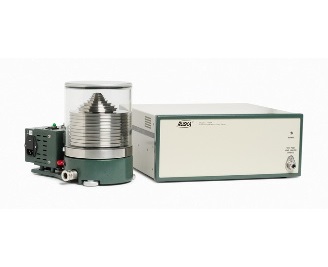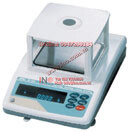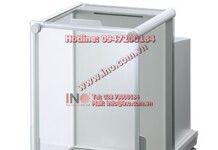Lưu ý: Tham khảo ý kiến của nhân viên INO sẽ giúp bạn tiết kiệm được thời gian và chi phí khi cần mua sắm. Với sự tư vấn của chúng tôi, bạn sẽ không gặp khó khăn khi tìm hiểu về đặc tính của sản phẩm cần mua.
- Pressure range: 0.4 to 103 inHg
- Optional range: 3.4 to 400 inHg
- Accuracy to ±0.5 feet, 0.003 knots
- Ideal for calibrating RVSM compliant test sets
- Absolute and gauge calibration for Ps, Pt & Qc ranges
- Calibrate in a variety of units
The Model 2468 Pitot Static Primary Standard is specifically designed for calibrating today’s high performance flight line and Air Data Test Systems. With the new autofloat controller, operator intervention is reduced to simply applying the mass load indicated by WinPrompt® software. WinPrompt applies all required correction factors, real time, to insure attainment of the highest level of performance available in a gas piston gauge which is required to calibrate today’s RVSM compliant test sets. The Model 2468 is based on the popular Model 2465 Gas Piston Gauge which has a long history of serving national standards laboratories, commercial industry and government organizations as a primary pressure standard for over 40 years. Time-proven materials, hand craftsmanship, and a lineage of intercomparisons to national standards laboratories at the highest levels are coupled with new automated technology to make the Model 2468 Pitot Static Primary Standard the world’s choice for calibrating Air Data Test Systems.
Automating the standard
The autofloat controller communicates through an RS-232C interface with WinPrompt software, a powerful Windows based calibration management program. WinPrompt automates all the functions required to perform an accurate calibration with ease. Since it is a Windows based application, it can communicate through the Dynamic Data Exchange (DDE) function with other Windows applications such as a word processor to provide customized calibration reports and spreadsheet applications to perform graphical or numerical analysis.
The process begins by creating a procedure file with the sequence of altitude or airspeeds required to calibrate a particular Pitot Static Tester. Although these instruments typically display altitude in feet and airspeed in knots, they usually require calibration in linear pressure units such as in.Hg or mbar. WinPrompt allows the procedure file to be setup in avionics units such as feet, meters, knots or pressure units such as inHg, mbar, kPa and many others. Once the procedure file has been created and saved, it can be recalled whenever the particular test set requires calibration, therefore minimizing setup time.
For each point to be generated, WinPrompt provides the operator with a list of masses (each individual mass is engraved with a unique sequence number) to apply to the top of the piston. The operator has the option of using trim masses supplied to generate an exact value, or accept the nominal value using only the main mass set.
With the first point selected, the operator uses the mouse to select the autofloat icon on the menu bar. The software then prompts the user to verify that the required masses have been applied. Upon confirmation by the user, the autofloat controller generates the requested pressure to the point where the piston is “floating”.
Once the pressure is established, the autofloat controller monitors all system parameters and updates the actual generated pressure, real-time. With a stable float position obtained, the status bar at the bottom of the screen changes from red to green indicating that the reading or adjustment of the device under test can be made. The device under test reading can be entered along with any particular comments in a separate text field. WinPrompt records this information along with the actual pressure generated by the Model 2468. The operator then proceeds through each step until all pressure points in the procedure file have been generated. Once the calibration procedure is complete, the calibration file can be saved with a unique file name and a calibration report can be printed. Since WinPrompt supports the Windows Dynamic Data Exchange (DDE) function of Windows, all information can be exported to a spreadsheet program to perform mathematical and graphical functions and/ or a word processing program for customized calibration report documents.
Piston/cylinder assemblies
For calibrating most Pitot Static Test Sets, only the standard piston/cylinder supplied is required. The standard piston/cylinder generates pressures from 1.4 to 103 inHg in autofloat mode and from 0.4 to 103 inHg using a manual pressure adjuster. This provides an effective altitude range from -610 to 19,812 meters (-2,000 to 65,000 feet) feet in autofloat mode -610 to 27,432 meters (-2,000 to 90,000 feet) using a manual adjuster) and airspeeds over 1,000 knots. An optional piston/cylinder is available for generating pressures from 3.4 to 400 inHg allowing calibration of other pressure related devices, such as pressure transducers.
Both the standard and optional piston/ cylinder assemblies are manufactured from proven materials that have evidenced superior strength, durability, low distortion, low thermal coefficients and virtually undetectable hysteresis over the last several decades, and have an unparalleled record of long-term stability. Each piston/cylinder installs quickly into the pressure column without the need for special tools. Piston/cylinder assembly change-out can be completed in less than one minute.
Mass set
The Model 2468 is provided with a single mass set that is used with either the standard or optional piston/cylinder. Each mass is engraved with a unique sequence number and a common serial number. A storage case is supplied which allows storage of the mass set and one or both piston/cylinders. Each mass is machined to a nominal value and is made from nonmagnetic materials to provide long-term stability and eliminate sensitivity to magnetic fields. For ease of use, the entire mass set totals just 12 kilograms (26.40 pounds), with a maximum platter mass of 1 kilogram (2.2 pounds). A laboratory grade trim mass set is included to allow any pressure increment within the range and resolution of the piston/cylinder assembly.
Instrument base
The instrument base is designed with functionality, economy and space conservation in mind. All electronic components are housed away from the instrument base to eliminate errors caused by thermal effects and magnetic fields. The thermally isolated motor drive is connected to the cylinder—eliminating pressure fluctuations and maximizing productivity. A durable, acrylic bell jar is provided to allow absolute mode operation when calibrating altitude and other absolute reference devices. A KF16 fitting is provided to simplify installation and allow low reference pressures
Vacuum pumps
In order to operate over the entire altitude and airspeed range, two vacuum pumps are required. One pump is connected to the reference port of the Model 2468 using a KF16 connection. This allows the area inside the bell jar to be evacuated which is required for altitude calibrations (absolute mode). A second vacuum pump is connected to the autofloat controller which allows automatic control of pressures down to 1.4 inHg absolute. In order to generate positive pressures, a regulated gas supply (clean dry air, or nitrogen) must be supplied to the autofloat controller. Fluke Calibration can supply vacuum pumps which are rated to the appropriate vacuum capacity and include an auto-vent valve and backstream filter for contamination prevention along with a muffler for quiet operation.
Connecting lines and fittings
Fluke Calibration can provide an optional lines and fittings kit which includes all interconnecting tubing for pressure and vacuum supplies along with all required cables and adapters.
Barometric reference
The Model 2468 equipped with the autofloat controller is provided with a barometric reference sensor to allow system operation in absolute mode and also simulated absolute mode where establishing the bell jar vacuum (reference vacuum) is not required.
Computer
The autofloat system requires a standard desktop or notebook computer for operation. A Pentium level processor, RS-232 interface and Windows 95/98 are the only requirements. The computer can be supplied by the customer or Fluke Calibration can provide an optional notebook computer with the system which is pre-loaded with Windows 95 or higher and WinPrompt software.
Manual configuration
Fluke Calibration also offers a manually operated pressure control system for setting the pressure and float position. This configuration can also be used with WinPrompt software and the Model 2456 Deadweight Gauge Monitor. The Model 2456 continuously monitors piston temperature, float position, and sink rate, and optionally air density and reference vacuum. WinPrompt calculates mass-to-pressure and pressure-to-mass values, and when used with the Model 2456, automatically reads and displays real-time piston gauge parameters. A separate brochure is available that covers the Model 2456 Deadweight Gauge Monitor.
Pressure Range
|
Autofloat Mode
Standard Piston/Cylinder |
Altitude: -2000 to 65,000 feet
Airspeed: 175 to 1000 knots
Pressure: 1.4 to 103 inHg (47 to 3500 mbar), gauge or absolute |
| Optional Piston/Cylinder |
Pressure: 7.5 to 400 inHg (255 mbar to 13.5 bar), gauge or absolute |
| Manual Mode |
Standard Piston/Cylinder Altitude: -2000 to 95,000 feet
Airspeed: 100 to 1000 knots
Pressure: 0.4 to 103 inHg (13.5 to 3500 mbar), gauge or absolute |
| Optional Piston/Cylinder |
Pressure: 3.4 to 400 inHg (115 mbar to 13.5 bar), gauge or absolute |
| Accuracy |
Altitude Accuracy Airspeed Accuracy
0 ft 0.5 ft 100 kts 0.003 kts
30,000 ft 1.0 ft 500 kts 0.003 kts
60,000 ft 3.8 ft 1000 kts 0.006 kts |
Piston/Cylinders: Standard
|
| Nominal Area |
0.52 in2 (3.4 cm2) |
| Pressure Range |
0.4 to 103 inHg (13.5 to 3500 mbar), gauge or absolute |
| Pressure Accuracy |
0.0010% RDG or 0.00003 inHg (0.001 mbar) (whichever is greater) |
| Pressure Stability |
3 ppm per year |
| Materials |
Piston is 440C stainless steel, cylinder is cemented tungsten carbide |
| Thermal Coefficient |
1.5E-05/°C |
Piston/Cylinder: Optional
|
| Nominal area |
0.13 in2 (0.84 cm2) |
| Pressure range |
3.4 to 400 inHg (115 mbar to 13.5 bar), gauge or absolute |
| Pressure Accuracy |
0.0026% RDG or 0.0008 inHg
(0.028 mbar) (whichever is greater) |
| Pressure Stability |
3 ppm per year |
| Materials |
Piston and cylinder are cemented tungsten carbide |
| Thermal coefficient |
9.1E-06/°C |
Mass Set
|
| Total mass |
26.4 lbs (12 kg) |
| Maximum Platter Mass |
2.2 lbs (1 kg)
Includes trim mass set (1 mg to 20g) and storage case |
General
|
| Electrical Power |
115/230 VAC, 50/60 Hz, 15 W |
| Temperature |
Operating temperature 15°C to 28°C
Storage temperature -20°C to 70°C |
| Humidity |
Operating humidity 20 to 75% relative humidity, Noncondensing
Storage humidity 0 to 90% relative humidity, Noncondensing |
| Pressure Medium |
High purity nitrogen or dry, clean air with less than 0.5 ppm hydrocarbon and less than 5 ppm H2O content, dew point less than or equal to -50°C, and less than 50 micron particulate size. Although lower quality gas can be used, the frequency of piston/cylinder cleaning will be increased. |
Autofloat System
|
| Positive shut-off controller |
Automatically generates pressure and maintains piston float position at desired pressure. |
| Float Position |
Inductive sensor
Float position resolution: 0.001 in or 0.001 cm
Sink rate resolution: 0.001 inch/minute or 0.001 cm/minute |
| Piston Temperature |
Four-wire 100W PRT
Accuracy: ±0.1°C per year
Resolution: 0.01°C |
| Air Density |
Sensor types
Temperature: thin film platinum 1000W RTD
Humidity: capacitive IC humidity sensor
Barometric pressure: piezoresistive, monolithic silicon pressure transducer
Accuracy
Temperature: ±2°C
Humidity: ±15%
Pressure: ±5 mmHg
|
| Vacuum Reference |
Thermopile sensor
Accuracy: 10% of reading or 10 mTorr (whichever is greater)
Resolution: 1 mTorr |
| Barometric Reference Sensor |
Accuracy: better than ±0.0008 inHg
Resolution: 0.0003 in.Hg |
Computer Interface
|
| Requirements |
Pentium level processor, RS-232C interface, monitor, mouse or other pointing device, keyboard; program requires 2 MB available hard disk space; Windows 95 or higher |
Manual Control Pack
|
| Manual Control Pack |
For users who prefer a manually operated system, the manual control pack can be provided with the Model 2468 instead of the autofloat controller.
The manual control pack includes pressure and vacuum inlet valves, precise pressure adjuster for fine pressure control, reference gauge and vent valve.
|
Lưu ý: Nếu một thiết bị nào đó không được liệt kê ở đây, điều đó không có nghĩa rằng chúng tôi không hỗ trợ được bạn về thiết bị đó.
Hãy liên hệ với chúng tôi để biết danh sách đầy đủ về thiết bị mà chúng tôi có thể hỗ trợ và cung cấp.
INO: Bán, Báo giá, tư vấn mua sắm và cung cấp, tư vấn sản phẩm thay thế; tương đương, hướng dẫn sử dụng, giá…VNĐ, …USD info@ino.com.vn | Tel: (+84) 028 73000184 | FLuke-Pitot/Static Primary Standard (Model:2468A).




















